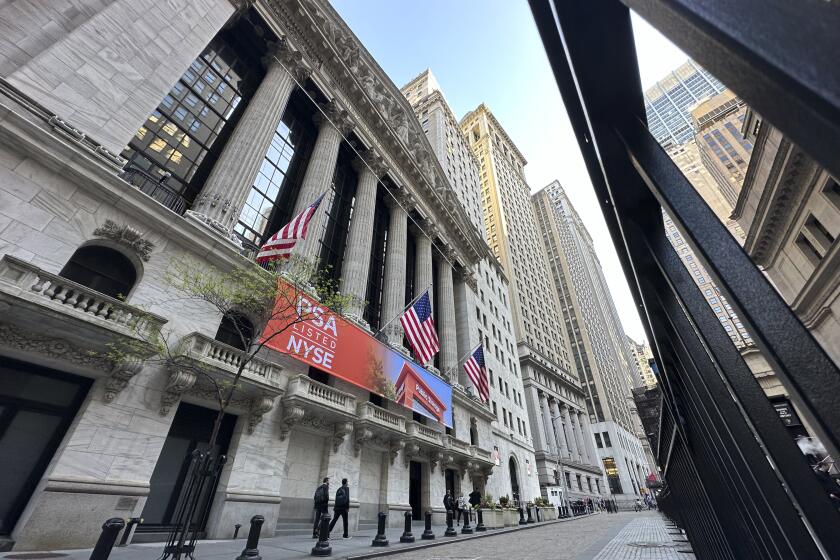Car Sales, High Electricity Bills Push Consumer Spending Up 0.9% in July
Consumer spending, bolstered by brisk auto sales and exceptional air-conditioning costs, soared 0.9% in July for the second month in a row--more than twice as fast as incomes grew, the government reported Monday.
The Commerce Department said personal income also was up, but more modestly: 0.4% in July, compared to 0.3% gains in May and June. It was the biggest income gain since an 0.6% advance in April.
With the growth of spending far outpacing the growth in incomes, Americans dipped deeper into their savings to make up the difference.
Personal savings, the ratio of savings to after-tax income, fell to 2.8% in July, down from 3.3% in June and from the 4.3% rate for all of 1986.
“The consumer has adapted very well to not saving any money,” said David Wyss, chief financial economist for Data Resources Inc. in Lexington, Mass. “One may wonder how long this can continue, but it appears low savings rates will be with us for a while.”
Despite the low savings, Monday’s report was greeted by economists as a strong sign for the economy and an indication that the nearly 5-year-old economic expansion is continuing.
Consumer spending makes up roughly two thirds of the gross national product.
“We’ve got a rebound in consumer spending going, but a small one,” said Sandra Shaber, an economist with the Futures Group, a Washington consulting business.
“But we should be cautious. This rebound is self-limiting. We have the low savings rate, high debt burdens and small wage gains. For many people, incomes are not even keeping up with inflation,” Shaber added.
White House spokesman Marlin Fitzwater, in Santa Barbara during President Reagan’s California vacation, commented: “Recent strong gains in personal consumption bode well for GNP growth in the third quarter.”
Inflation for the first seven months of 1987 has been running at an annual rate of 5%, based on the consumer price index.
Analysts said the heat wave in many parts of the nation this summer contributed to the brisk spending figures as electricity bills surged.
Automobile sales also remained high, as dealers offered price and financing bargains to clear their lots before the introduction of 1988 models.
“This increase in car sales is temporary. It’s the annual unloading of all spare dogs and cats during the summer months, a factor that will be reversed in the fall,” said Michael K. Evans, president of a Washington-based private economic consulting service.
However, the increase in spending this summer was across a wide range of products and not limited to automobiles and higher electricity charges.
“We are seeing a re-emergence of a solid pace of consumer spending,” said Allen Sinai, chief economist for Shearson Lehman Bros. in New York.
“The economy can use a good shot of outlays by consumers,” he said. “But the figures raise a warning flag. If the kind of results that appeared in June and July were to recur for another month or two, the concern that consumers were outpacing themselves would arise again.”
The two months of 0.9% consumer-spending increases followed a 0.2% gain in May. The twin gains were the highest since a 2.3% surge in February.
Personal consumption spending, which includes nearly everything except interest payments on debt, rose at an annual rate of $25.6 billion in July, following an increase of $26.9 billion in June.
In July, Americans were spending at the equivalent of an annual seasonally adjusted rate of $2.99 trillion, up from $2.97 trillion in June, the agency said.
Purchases of durable goods, items expected to last three years or more, increased $5.9 billion from June to July to an adjusted annual rate of $418 billion. It is this category that includes automobiles.
In June, durable good purchases had increased $9.8 billion, for an annual adjusted rate of $412 billion.
Purchases of non-durable goods increased $5.9 billion in July to an annual adjusted rate of $992 billion.
Purchases of services, a broad category which includes everything from electricity costs to housing and restaurant meals, rose $14.5 billion in July to an annual rate of $1.23 trillion.
Americans’ disposable, or after-tax, income increased 0.4% in July after creeping down 0.2% in June.
Wages and salaries, the key component in the incomes category, increased at an annual rate of $5.4 billion in July, down slightly from a $5.9-billion June advance.
Manufacturing payrolls decreased by $200 million in July, after a $500-million advance the month before.
Farm income increased, but only barely, by $100 million in July after a $2.5-billion increase in June.






